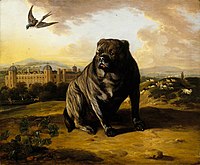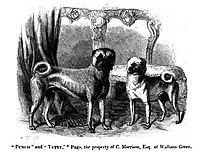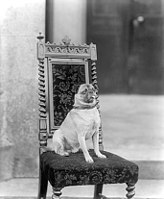Pug
| Pug | |||||||||||||||||
|---|---|---|---|---|---|---|---|---|---|---|---|---|---|---|---|---|---|
 A fawn-colored pug, the most common coloring. | |||||||||||||||||
| Origin | China[1] | ||||||||||||||||
| |||||||||||||||||
| |||||||||||||||||
| Dog(domestic dog) | |||||||||||||||||
ThePugis abreed of dogwith the physically distinctive features of a wrinkly, short-muzzled face, and curled tail. An ancient breed, with roots dating back to 400 B.C.,[2]they have a fine, glossy coat that comes in a variety of colors, most oftenfawn(light brown) or black, and a compact, square body with well developed and thick muscles all over the body.
Pugs were brought from China to Europe in the sixteenth century and were popularized in Western Europe by theHouse of Orangeof the Netherlands, and theHouse of Stuart.[3]In the United Kingdom, in the nineteenth century,Queen Victoriadeveloped a passion for Pugs which she passed on to other members of the royal family.
Pugs are known for being sociable and gentlecompanion dogs.[4]TheAmerican Kennel Clubdescribes the breed's personality as "even-tempered and charming".[5]Pugs remain popular into the twenty-first century, with some famous celebrity owners. The dogs are susceptible to various health problems due to their bred traits.[6]
Etymology
[edit]There are several theories as to the origin of the name "pug". Some sources state the breed was named after the marmoset monkey, a popular exotic pet during the 18th century, which was also known as the "Pug-monkey".[7]The Pug probably acquired its moniker on account of its flat face loosely resembling that of a primate.
Another popular belief is that it's derived from the Latin "pugnus" meaning "fist". Early Pugs were commonly cropped and supposedly that alteration resulted in a head that looked like the shadow of a closed fist when viewed from the side.[8]
TheOxford English Dictionaryhas the word "pug" as in the dog breed being descended from the meaning of "A dwarf animal, an imp, etc.". Since the late 16th century the term "pug" has been used in English to describe squirrels, hares, foxes, ferret, salmon, sheep, and monkeys. The first attestation of "Pug-dog" is in 1749. The OED also notes it may be related to a now obsolete term of endearment for a person or animal.[9]
Description
[edit]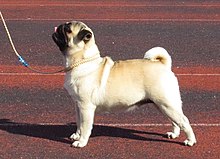
Physical characteristics
[edit]While the Pugs that are depicted in eighteenth century prints tend to be long and lean,[3]modern breed preferences are for a squarecobbybody, a compact form, a deep chest, and well-developed muscle.[5]Their smooth and glossy coats can be fawn, apricot fawn, silver fawn, or black.[5][10]The markings are clearly defined and there is a trace of a black line extending from the occiput to the tail.[5]The tail normally curls tightly over the hip.[3]
The Pug's muzzle is blunt and very short giving a square shaped appearance to the head.[5]
Pugs have two distinct ear shapes, "rose" and "button". "Rose" ears are smaller than the standard style of "button" ears, and are folded with the front edge against the side of the head. Breeding preference goes to "button" style ears.[11]
Pugs' legs are strong, straight, of moderate length, and are set well under. Their shoulders are moderately laid back. Their ankles are strong, their feet are small, their toes are well split-up, and their nails are black.[5]The lower teeth normally protrude further than their upper, resulting in an under-bite.[1]
Temperament
[edit]The American Kennel Club says the motto of the breed is the Latin phrasemultum in parvo,or "much in little" or "a lot of dog in a small space".[1]Pugs tend to be intuitive and sensitive to the moods of their owners and are usually eager to please them.[4]Pugs are playful and thrive on human companionship. Pugs are often called "shadows" because they follow their owners around and like to stay close to the action, craving attention and affection from their owners.[12]
History
[edit]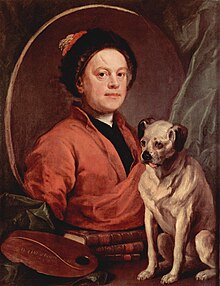
Chinese origins
[edit]The ancestor of the Pug was a dog called the Lo-Chiang-Sze, or Lo-Sze in its shortened form.[7]That name explicitly refers to a short-legged, short-mouthed[13]and, most importantly, short-coated dog, potentially as a way to distinguish it from thePekingese,which was of similar build. Many people today refer to it as the "ancient pug".
The Lo-sze was popular in the imperial court during theSong dynasty[14]and was brought from China to Europe in the sixteenth century by theDutch East India Company.[3]The Happa or Hap-pah dog has also been considered as playing a part in the formation of the modern Pug breed, but it was not acquired by European fanciers until 1860 when specimens were looted by French and British troops during their complete destruction of theOld Summer Palace(Yuanmingyuan) in Beijing, during theSecond Opium War.[15]
In ancient times, Pugs were bred to be companions for ruling families in China. Pet Pugs were highly valued by Chinese emperors, and the royal dogs were kept in luxury and guarded by soldiers.[4]Pugs later spread to other parts of Asia. InTibet,Buddhist monks kept Pugs as pets in their monasteries.[4]The breed has retained its affectionate devotion to its owners since ancient times.[4]
16th and 17th centuries
[edit]Pugs became popular at European courts, and reportedly became the official dog of theHouse of Orangein 1572, after a Pug namedPompeysaved the life of the Prince of Orange by alerting him to the approach of assassins.[1]
A Pug traveled withWilliam IIIandMary IIwhen they left theNetherlandsto accept the throne of England in 1688.[3]During that period, the Pug may have been bred with the old-type King Charles spaniel, giving the modernKing Charles Spanielits pug-like characteristics.[16]
The breed eventually became popular in other European countries as well. Pugs were painted byGoyain Spain, and in Italy they rode up front on private carriages, dressed in jackets and pantaloons that matched those of the coachman. They were used by the military to track animals and people, and were also employed asguard dogs.[3]
18th century to 20th century
[edit]
The English painterWilliam Hogarthwas the devoted owner of a series of Pugs.His 1745 self-portrait,which is now in London'sTate Gallery,includes his Pug,Trump.[17]The Pug was also well known in Italy. In 1789, authorHester Piozziwrote in her journal: "The little Pug dog or Dutch mastiff has quitted London forPadua,I perceive. Every carriage I meet here has a Pug in it. "[18][19]
The popularity of the Pug continued to spread in France during the eighteenth century. Before her marriage toNapoleon Bonaparte,Joséphinehad her Pug, Fortune, carry concealed messages to her family while she was confined at Les Carmes prison, it having alone been given visiting rights.[20]
In nineteenth-century England, the breed flourished under the patronage ofQueen Victoria.Her many Pugs, which she bred herself, included Olga, Pedro, Minka, Fatima and Venus.[3]Her involvement with dogs in general helped to establish theKennel Club,which was formed in 1873.[3]Queen Victoria favored apricot and fawn colors. Her passion for Pugs was passed on to many other members of the royal family, including her grandsonKing George V[21]and his sonKing Edward VIII.Many responded to the breed's image of anti-functionalism and diminutive size during that period.[22]
In paintings and engravings of the 18th and 19th centuries, Pugs usually appear with longer legs and noses than today, and sometimes with cropped ears. That practice was carried out in Europe up until the 19th century, the intent being to accentuate the wrinkles of the forehead.[23]The so-called "prince mark" – a set of wrinkles resembling the Chinese character for prince ( vương ) – was a desirable attribute of the breed.[24]
It was around this time that two prolific strains of Pug came to be known in Britain: the Morrison and Willoughby lines.[25]Dogs of the Willoughby line were said to be of "bad colour", stone fawn with an excess of black on the head, whereas Morrison Pugs were a richer yellow fawn with well defined black masks.[26]
The Morrison Pug was more in accordance with current breed type, being cobbier and shorter muzzled. In his book,The Dogs of the British Islands,J.H. Walsh writes that the first dog of the Willoughby line had "a face much longer than would now be approved of by Pug fanciers".[27]Comparison of the two strains, as depicted in artwork from the time, provides a clearer image as to their distinct characteristics.
The modern Pug's appearance probably changed after 1860, when a new wave of dogs were seized as loot by French and British soldiers who razed the Old Summer Palace in Beijing (then Peking), China.[28]They were "Happa dogs", or "Pekingese pugs" as they would come to be known by the western fancier.[29]Those Pugs had shorter legs, the modern-style Pug nose[15]and were often black and white in colour.
The Happa dog probably constitutes a separate "strain" to the Pekingese, rather than a breed in its own right. W.E Mason remarks in his book "Dogs of all nations" that the Happa is "identical in every respect with the Pekingese Spaniel, except that his coat is short and smooth".[30]The distinction between the long and short coated dogs was, most likely, imposed by the British as several Oriental scrolls depict long coated "Hap-pah" dogs.
Two of the most famous Happa dogs to be brought back to England were "Moss" and "Lamb" who were bred together to produce "Click".[25]A popular stud, "Click" was bred several times to bitches of both Willoughby and Morrison lines, which is largely recognized as leading to the merging of both strains.
During that period, crossing with the English bulldog reportedly took place to solidify desirable traits in both breeds, though that improvement came at the expense of the Pugs diminutive stature.[31]Pug dogs with a broader head and flatter muzzle were procured through those mixed pairings. However, many of them lacked the temperament typical of a lap dog on account of the bulldog's fiercer nature.[32]
The Britisharistocrat,Lady Brassey, is also credited with making black Pugs fashionable after she brought some back from China in 1886.[1][3]
Pugs arrived in the United States during the nineteenth century and were soon making their way into the family home and the show ring.[3]TheAmerican Kennel Clubrecognized the breed in 1885. The Pug Dog Club of America was founded in 1931 and was recognized by the American Kennel Club that same year. In 1981, the PugDhandys Favorite Woodchuckwon theWestminster Kennel Club Dog Showin the United States, the only Pug to have won there since the show began in 1877.[33]
21st century
[edit]

The World Champion – or Best in Show – at the 2004World Dog Showheld inRio de Janeiro,was a Pug namedDouble D Cinoblu's Masterpiece.[34][35]
Retro Pugs
[edit]The breeding trend of Pugs led to shorter muzzles and shorter legs over time, with the dogs susceptible to some health problems. In 2023, the Netherlands placed limitations on the breeding of various short-faced breeds, including the conventional Pug.[36]Since around 2006 there has been a counter-trend in some countries to breed "retro pugs". Breeders who pursue that change in the breed aim for longer snouts, less protruding eyes, straighter legs and fewer facial wrinkles.[37][38][39]
Health problems
[edit]Brachycephaly
[edit]Since Pugs lack longer snouts and prominentskeletal brow ridges,they are susceptible to eye injuries such asproptosis,scratchedcorneas,and painfulentropion.[3]The shortened snout and pushed in face of the Pug is known asbrachycephaly.[40]Brachycephaly results in deformation of the upper airway tract and leads to obstruction of breathing.[41][42][43]Potential effects of brachycephaly arestridor,stertorous breathing,emesis,skin fold dermatitis,brachycephalic airway obstructive syndrome,exophthalmos,pharyngeal gag reflex,cyanosis,and laryngeal collapse.[44][45][42][46][47][48][49]
Other issues arising from brachycephaly are risk of complications whilst under anaesthesia,[50]andhyperthermia– with the latter caused due to an inability to effectively reduce body temperature via panting.[51]Their breathing problems can be worsened by the stresses of traveling in air cargo, which may involve high temperatures. Following the deaths of Pugs and other brachycephalic breeds, several airlines either banned their transport in cargo or enacted seasonal restrictions.[52][53]
Obesity
[edit]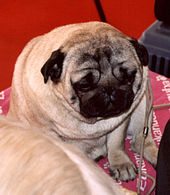
Research from the UK found that Pugs are more prone to obesity than other breeds. They are three times more likely to become obese, and one in every five Pugs are diagnosed as obese in a year.[54]Obesity should be considered a health priority in Pugs because of the high prevalence, associated health problems and reversible nature of the disorder.[55]
Life expectancy
[edit]A study in the UK of veterinary records found the Pug to have a life expectancy of 7.65 years – far below the average of 11.23 years.[56]Another UK study found a life expectancy of 11.6 years for the breed compared to an average of 12.7 for purebreeds and 12 forcrossbreeds.[57]A review of pet cemetery data in Japan found the Pug to have a life expectancy of 12.8 years, below the average of 13.7 years and lower than the average for small breeds.[58][1]

Inbreeding depression
[edit]In 2008,an investigative documentarycarried out by theBBCfound significant inbreeding between pedigree dogs, with a study by Imperial College, London, showing that the 10,000 Pugs in the UK were so inbred that their gene pool was the equivalent of only 50 individual humans.[59][better source needed]
Other conditions
[edit]An abnormal formation of the hip socket, known aship dysplasia,affected nearly 64% of Pugs in a 2010 survey performed by theOrthopedic Foundation for Animals.The breed was ranked the second-worst-affected by the condition out of 157 breeds tested.[60]
In a British study the Pug was found to be more susceptible todemodicosis.The prevalence of the condition in Pugs under two years was 1.9% compared to the 0.48% average, and for Pugs over four years it was 0.2% compared to the 0.05% average. Overall, the Pug had a prevalence of 1% compared to the 0.17% average.[61]
Pugs can suffer fromnecrotizing meningoencephalitis(NME), also known as Pug Dog Encephalitis (PDE), aninflammationof the brain andmeninges.[62]NME is not unique to Pugs and also occurs in other small dogs, such as theYorkshire Terrier,Maltese,andChihuahua.[62]NME affects roughly 1–2% of all Pugs.[63]
The Pug is prone tohemivertebrae,a condition that can lead to pain as well as loss of function in the hind legs.[64]
A UK study found the Pug to be at a 7.49 times greater risk of impaired hepatic perfusion compared to other dogs.[65]
Birth and reproduction
[edit]Due to the relative size of neonatal skulls to the birth canal, Pugs are highly predisposed to requiring cesarean births.[66]
Historical depictions of Pugs
[edit]-
A Dutch Mastiff (called 'Old Vertue') withDunham Masseyin the Background "(Jan Wyck,1700)
-
A portrait of PrincessEkaterina GolitsynabyLouis-Michel van Loo(1759)
Moscow,Pushkin Museum of Fine Arts -
Children of the Marquis de Béthune with a Pug, 1761
-
A male Pug, 1802
-
Portrait of Sylvie de la Rue, circa 1810
-
Young Lady in a Boatwith a Pug byJames Tissot,1870
-
Engraving of the Pugs "Punch and Tetty" from the 1859 book "The Dog in Health and Disease"
-
Pug from 1915.
-
Pug photo, ca 1900. Note its small head and long legs.
-
A Pug by Carl Reichert. (1836–1918)
In popular culture
[edit]The breed became iconic in India, as it was featured as the mascot in a series ofVodafone(formerlyHutchison Essar) advertising commercials directed byPrakash Varma.The Pug that was predominantly featured in the commercials wasCheeka.[67][68]The advertisement campaign was followed by a rise in the popularity of Pugs in India, and the sale of Pugs more than doubled within months, with prices for Pugs rising considerably. A few other adverts also appeared in the following months, inspired by the idea of a dog following a boy.[69]
InJane Austen's 1814 novel,Mansfield Park,Lady Bertram, the hero's mother, owned a pet Pug and was "thinking more of her Pug than her children".[70]
The 1989 filmThe Adventures of Milo and Otisfeatures a Pug named Otis, known as "Poosky" in the original 1986 Japanese version,The Adventures of Chatran.[citation needed]
TheMen in Blackfilm series featuresFrank,a fictional talking Pug portrayed by animal actor Mushu.[71]
See also
[edit]Notes
[edit]- 1.^The Japanese study reviewed cemetery data which is unlikely to have any records of still-births and altricial deaths whilst a veterinary clinic likely would have data on these.
References
[edit]- ^abcde"American Kennel Club - Pug History".AKC.org.American Kennel Club.Archivedfrom the original on 13 March 2018.Retrieved19 August2006.
- ^"Pug: Description, Weight, Temperament, & Facts".Encyclopædia Britannica.23 January 2024.Archivedfrom the original on 19 January 2024.Retrieved29 February2024.
- ^abcdefghijkFarr, Kendall; Montague, Sarah (1999).Pugs in Public.New York: Stewart, Tabori & Chang, a division of U.S. Media Holdings.ISBN1-55670-939-0.
- ^abcdeSeptember Morn (2010).Our Best Friends: The Pug.Pittsburgh: ElDorado Ink. pp. 11, 14–15.ISBN978-1-932904-71-0.Archivedfrom the original on 29 February 2024.Retrieved2 April2015.
- ^abcdef"American Kennel Club - Pug".AKC.org.Archivedfrom the original on 24 August 2012.Retrieved14 October2008.
- ^O'Neill, Dan G.; Sahota, Jaya; Brodbelt, Dave C.; Church, David B.; Packer, Rowena M.A.; Pegram, Camilla (18 May 2022)."Health of Pug dogs in the UK: disorder predispositions and protections".Canine Medicine and Genetics.9(1): 4.doi:10.1186/s40575-022-00117-6.ISSN2662-9380.PMC9115981.PMID35581668.
- ^abFlaim, Denise (27 August 2021)."Pug History: Origins of the Ancient, Wrinkly Companion Dog".American Kennel Club.Retrieved6 March2024.
- ^"Chapter X. The Pug".chestofbooks.com.Retrieved6 March2024.
- ^"pug, n.²".Oxford English Dictionary.Oxford University Press. 2 March 2023.doi:10.1093/oed/7135363746.
- ^Color: The colors are fawn or black. The fawn color should be decided so as to make the contrast complete between the color and the trace and mask.
- ^"Ears".Pugs.org.Pug Dog Club of America. Archived fromthe originalon 15 October 2008.Retrieved14 October2008.
- ^Belmonte, Brenda (2004).The Pug Handbook.New York: Barron's Educational Series Inc. p.13.ISBN978-0-7641-2488-4.
pug craves attention.
- ^"The Lo-Sze".National Purebred Dog Day®.5 September 2020.Retrieved3 March2024.
- ^Collier, V. W. F. (1921).Dogs of China & Japan, in nature and art.W. Heinemann, London. p.147.
The Lo-Chiang dog was a "pai" dog and consequently small, "short-headed," and "short-legged" before 1000 C.E. It was very possibly the Chinese Pug and appears to have been fashionable at the Chinese court from the beginning of the eighth century to the middle of the eleventh century, possibly even up to the removal of the capital from Hsianfu (Xi'an) to Peking (Beijing) in about 1153 C.E.
- ^abLoades, Mike (2 December 2020).Dogs: Working Origins and Traditional Tasks.White Owl.ISBN978-1-5267-4230-8.
- ^Moffat, Norma (27 March 2006).Cavalier King Charles Spaniel: Your Happy Healthy Pet(2nd ed.). Howell Book House. p.19.ISBN0-471-74823-4.
- ^William Hogarth. The Painter and his Pug, 1745.Archived6 May 2013 at theWayback MachineTate Gallery, London, England.www.tate.org.uk.Retrieved 9 April 2013.
- ^Maggitti, Phil (2000).Pugs: Everything about Purchase, Care, Nutrition, Behavior, and Training.Barron's Educational Series. p.10.ISBN978-0-7641-1045-0.Retrieved17 January2010.
pug.
- ^Wilhelmina Swainston-Goodger (5 March 2013).The Pug-Dog - Its History and Origin.Read Books Limited. pp. 50–.ISBN978-1-4474-8817-0.Archivedfrom the original on 29 February 2024.Retrieved22 March2020.
- ^Macdonogh, Katharine (August 1996). "Prison Pets in the French Revolution".History Today.46.
- ^"Royal Collection - The Duke of York holding a Pug".royalcollection.org.uk.Archivedfrom the original on 24 September 2015.Retrieved6 September2013.
- ^Yang, C. (2012). Culture in Miniature: Toy Dogs and Object Life. Eighteenth Century Fiction, 25(1), 139-174.
- ^"Things you should know before owning a Pug".www.anniebees.com.Retrieved2 March2024.
- ^"The Prince Mark".National Purebred Dog Day.14 May 2016.Retrieved2 March2024.
- ^ab"Willoughby and Morrison Pugs".National Purebred Dog Day®.31 March 2020.Retrieved2 March2024.
- ^"The Pug. Part 2".chestofbooks.com.Retrieved2 March2024.
- ^"Chapter II. Smooth Toy Dogs. The Pug".chestofbooks.com.Retrieved2 March2024.
- ^"Pugs in Ancient Orient".mypugs.atwebpages.com.Retrieved3 March2024.
- ^Rodin, Therese (20 February 2020)."Happa/Lo-sze/Chinese Pugs – the Chinese origin".Pugdogpassion.Retrieved3 March2024.
- ^"The Project Gutenberg eBook of Dogs of all nations, by W. E. Mason".www.gutenberg.org.Retrieved3 March2024.
- ^"Smooth Toy Dogs. The Pug. Continued".chestofbooks.com.Retrieved6 March2024.
- ^https://www.britishnewspaperarchive.co.uk/viewer/bl/0003408/18930401/031/0002.Retrieved6 March2024– viaBritish Newspaper Archive.
{{cite web}}:Missing or empty|title=(help) - ^Cunliffe, Juliette."History of the Pug".DogChannel.com.Archived fromthe originalon 13 May 2016.Retrieved26 December2009.
- ^"Interview with Ann Joe Sampaio, owner of Double D Cinoblu's Masterpiece".World Dog Show2015. 27 February 2014. Archived fromthe originalon 26 April 2016.Retrieved18 April2016.
- ^"DOUBLE D CINOBLU'S MASTERPIECE".Pedigree Online.Archivedfrom the original on 19 February 2024.Retrieved19 February2024.
- ^"Netherlands puts further limits on breeding flat-faced dogs".NL Times.24 August 2023.Archivedfrom the original on 29 February 2024.Retrieved15 December2023.
- ^Retro PugArchived5 August 2021 at theWayback Machine,Zooplus magazine,accessed: 5 August 2021.
- ^Qualzucht im Fokus: Der MopsArchived13 August 2021 at theWayback Machine,Welttierschutz.org, 22 August 2019.
- ^Waterfield, Bruno (23 January 2023)."Dutch ban on pugs and French bulldogs puts owners' noses out of joint".The Times.Archivedfrom the original on 6 February 2024.Retrieved6 February2024.
- ^Knecht, C. D. (1979). Upper airway obstruction in brachycephalic dogs. Compend Contin Educ Pract Vet, 1, 25-31.
- ^Oechtering, Gerhard U.; Pohl, Sabine; Schlueter, Claudia; Lippert, Johanna P.; Alef, Michaele; Kiefer, Ingmar; Ludewig, Eberhard; Schuenemann, Riccarda (21 January 2016). "A Novel Approach to Brachycephalic Syndrome. 1. Evaluation of Anatomical Intranasal Airway Obstruction".Veterinary Surgery.45(2). Wiley: 165–172.doi:10.1111/vsu.12446.ISSN0161-3499.PMID26790550.
- ^abHendricks, Joan C. (1992)."Brachycephalic Airway Syndrome".Veterinary Clinics of North America: Small Animal Practice.22(5). Elsevier BV: 1145–1153.doi:10.1016/s0195-5616(92)50306-0.ISSN0195-5616.PMID1523786.
- ^Ekenstedt, K.J.; Crosse, K.R.; Risselada, M. (2020)."Canine Brachycephaly: Anatomy, Pathology, Genetics and Welfare".Journal of Comparative Pathology.176.Elsevier BV: 109–115.doi:10.1016/j.jcpa.2020.02.008.ISSN0021-9975.PMC7380493.PMID32359622.
- ^TC, Amis; C, Kurpershoek (1986)."Pattern of breathing in brachycephalic dogs".American Journal of Veterinary Research.47(10). Am J Vet Res: 2200–2204.ISSN0002-9645.PMID3777646.Archivedfrom the original on 6 February 2024.Retrieved6 February2024.
- ^Hendricks, J. C.; Kline, L. R.; Kovalski, R. J.; O'Brien, J. A.; Morrison, A. R.; Pack, A. I. (1 October 1987). "The English bulldog: a natural model of sleep-disordered breathing".Journal of Applied Physiology.63(4). American Physiological Society: 1344–1350.doi:10.1152/jappl.1987.63.4.1344.ISSN8750-7587.PMID3693167.
- ^Meola, Stacy D. (2013). "Brachycephalic Airway Syndrome".Topics in Companion Animal Medicine.28(3). Elsevier BV: 91–96.doi:10.1053/j.tcam.2013.06.004.ISSN1938-9736.PMID24182996.
- ^Lundgrun, Becky (26 June 2006)."Reverse Sneezing (Pharyngeal Gag Reflex)".VeterinaryPartner.com.Archivedfrom the original on 4 February 2018.Retrieved26 December2009.
- ^Sebbag, Lionel; Sanchez, Rick F. (2023)."The pandemic of ocular surface disease in brachycephalic dogs: The brachycephalic ocular syndrome".Veterinary Ophthalmology.26(S1): 31–46.doi:10.1111/vop.13054.ISSN1463-5216.PMID36585820.
- ^Hobi, Stefan; Barrs, Vanessa R.; Bęczkowski, Paweł M. (16 June 2023)."Dermatological Problems of Brachycephalic Dogs".Animals.13(12). MDPI AG: 2016.doi:10.3390/ani13122016.ISSN2076-2615.PMC10294810.PMID37370526.
- ^Gruenheid, Michaela; Aarnes, Turi K.; McLoughlin, Mary A.; Simpson, Elaine M.; Mathys, Dimitria A.; Mollenkopf, Dixie F.; Wittum, Thomas E. (1 August 2018). "Risk of anesthesia-related complications in brachycephalic dogs".Journal of the American Veterinary Medical Association.253(3). American Veterinary Medical Association (AVMA): 301–306.doi:10.2460/javma.253.3.301.ISSN0003-1488.PMID30020004.S2CID51676839.
- ^Ewers Clark, Anna (22 December 2022)."Heatstroke and brachycephalic dogs – is there an increased risk?".Veterinary Evidence.7(4).doi:10.18849/ve.v7i4.534.ISSN2396-9776.
- ^"Air Travel and Short-Nosed Dogs FAQ".American Veterinary Medical Association.Archivedfrom the original on 12 June 2019.Retrieved7 July2014.
- ^Haughney, Christine (6 October 2011)."Banned by Many Airlines, These Bulldogs Fly Private".The New York Times.Archived fromthe originalon 7 October 2011.Retrieved7 July2014.
- ^"Research shows Pugs at highest risk of obesity".British Small Animal Veterinary Association.27 January 2023.Archivedfrom the original on 6 February 2024.Retrieved6 February2024.
- ^O'Neill, Dan G.; Darwent, Elisabeth C.; Church, David B.; Brodbelt, Dave C. (10 June 2016)."Demography and health of Pugs under primary veterinary care in England".Canine Genetics and Epidemiology.3(1): 5.doi:10.1186/s40575-016-0035-z.ISSN2052-6687.PMC4903005.PMID27293771.
- ^Teng, Kendy Tzu-yun; Brodbelt, Dave C.; Pegram, Camilla; Church, David B.; O'Neill, Dan G. (28 April 2022)."Life tables of annual life expectancy and mortality for companion dogs in the United Kingdom".Scientific Reports.12(1). Springer Science and Business Media LLC: 6415.Bibcode:2022NatSR..12.6415T.doi:10.1038/s41598-022-10341-6.ISSN2045-2322.PMC9050668.PMID35484374.
- ^McMillan, Kirsten M.; Bielby, Jon; Williams, Carys L.; Upjohn, Melissa M.; Casey, Rachel A.; Christley, Robert M. (1 February 2024)."Longevity of companion dog breeds: those at risk from early death".Scientific Reports.14(1). Springer Science and Business Media LLC: 531.Bibcode:2024NatSR..14..531M.doi:10.1038/s41598-023-50458-w.ISSN2045-2322.PMC10834484.PMID38302530.
- ^Inoue, Mai; Kwan, Nigel C. L.; Sugiura, Katsuaki (2018)."Estimating the life expectancy of companion dogs in Japan using pet cemetery data".Journal of Veterinary Medical Science.80(7). Japanese Society of Veterinary Science: 1153–1158.doi:10.1292/jvms.17-0384.ISSN0916-7250.PMC6068313.PMID29798968.
- ^"Pedigree dogs plagued by disease".BBC News.19 August 2008.Archivedfrom the original on 18 September 2008.Retrieved26 December2009.
- ^"Hip Dysplasia Statistics: Hip Dysplasia by Breed".OFFA.org.Ortheopedic Foundation for Animals. Archived fromthe originalon 19 October 2010.Retrieved14 October2010.
- ^O'Neill, D. G.; Turgoose, E.; Church, D. B.; Brodbelt, D. C.; Hendricks, A. (2020)."Juvenile-onset and adult-onset demodicosis in dogs in the UK: prevalence and breed associations".Journal of Small Animal Practice.61(1): 32–41.doi:10.1111/jsap.13067.ISSN0022-4510.PMC7003809.PMID31584708.
- ^abCynthia M. Kahn, BA MA, ed. (2010).The Merck Veterinary Manual(10th ed.). Kendallville, Indiana: Courier Kendallville, Inc. pp. 1119, 1158.ISBN978-0-911910-93-3.
- ^Windsor, Rebecca; Stewart, Samuel; Schmidt, Jessica; Mosqueda, Mario; Piras, Ignazio; Keller, Stefan M.; Steinmetz, Briana; Borjesson, Dori L.; Huentelman, Matthew; Khanna, Chand (2022)."A potential early clinical phenotype of necrotizing meningoencephalitis in genetically at-risk pug dogs".Journal of Veterinary Internal Medicine.36(4): 1382–1389.doi:10.1111/jvim.16444.ISSN0891-6640.PMC9308433.PMID35621070.
- ^"Hemivertebrae".Genetic Welfare Problems of Companion Animals.ufaw.org.uk: Universities Federation for Animal Welfare. Archived fromthe originalon 12 March 2015.Retrieved11 September2014.
- ^Bandara, Y.; Bayton, W. A.; Williams, T. L.; Scase, T.; Bexfield, N. H. (2021). "Histopathological frequency of canine hepatobiliary disease in the United Kingdom".Journal of Small Animal Practice.62(9): 730–736.doi:10.1111/jsap.13354.ISSN0022-4510.PMID34155648.
- ^Evans KM, Adams VJ. Proportion of litters of purebred dogs born by caesarean section. J Small Anim Pract. 2010 Feb;51(2):113-8.doi:10.1111/j.1748-5827.2009.00902.x.PMID20136998.
- ^"The perils of being the Vodafone pug".India Times.23 November 2016.Archivedfrom the original on 1 December 2017.Retrieved19 November2017.
- ^"Return of the Vodafone pug".livemint.com.14 March 2016.Archivedfrom the original on 24 November 2017.Retrieved19 November2017.
- ^Jaypal, Renuka.Going Digital in IndiaArchived15 October 2006 at theWayback Machine,Viewpoint,May 2006, retrieved 24 November 2006.
- ^Austen, Jane (1814).Mansfield Park.
- ^"PUG IN BLACK: FRANK WALKS AWAY WITH MIIB".courant.com.9 July 2002.Archivedfrom the original on 19 October 2020.Retrieved5 May2020.

